
A | B | C | D | E | F | G | H | CH | I | J | K | L | M | N | O | P | Q | R | S | T | U | V | W | X | Y | Z | 0 | 1 | 2 | 3 | 4 | 5 | 6 | 7 | 8 | 9
This article needs additional citations for verification. (November 2022) |

Rail transport (also known as train transport) is a means of transport using wheeled vehicles running in tracks, which usually consist of two parallel steel rails.[1] Rail transport is one of the two primary means of land transport, next to road transport. It is used for about 8% of passenger and freight transport globally,[2] thanks to its energy efficiency[2] and potentially high speed.
| Part of a series on |
| Rail transport |
|---|
 |
|
|
| Infrastructure |
|
|
| Service and rolling stock |
|
| Special systems |
|
|
| Miscellanea |
|
|
Rolling stock on rails generally encounters lower frictional resistance than rubber-tyred road vehicles, allowing rail cars to be coupled into longer trains. Power is usually provided by diesel or electrical locomotives. While railway transport is capital-intensive and less flexible than road transport, it can carry heavy loads of passengers and cargo with greater energy efficiency and safety.[a]
Precursors of railways driven by human or animal power have existed since antiquity, but modern rail transport began with the invention of the steam locomotive in the United Kingdom at the beginning of the 19th century. The first passenger railway, the Stockton and Darlington Railway, opened in 1825. The quick spread of railways throughout Europe and North America, following the 1830 opening of the first intercity connection in England, was a key component of the Industrial Revolution. The adoption of rail transport lowered shipping costs compared to water transport, leading to "national markets" in which prices varied less from city to city.
In the 1880s, railway electrification began with tramways and rapid transit systems. Starting in the 1940s, steam locomotives were replaced by diesel locomotives. The first high-speed railway system was introduced in Japan in 1964, and high-speed rail lines now connect many cities in Europe, East Asia, and the eastern United States. Following some decline due to competition from cars and airplanes, rail transport has had a revival in recent decades due to road congestion and rising fuel prices, as well as governments investing in rail as a means of reducing CO2 emissions.
History
Smooth, durable road surfaces have been made for wheeled vehicles since prehistoric times. In some cases, they were narrow and in pairs to support only the wheels. That is, they were wagonways or tracks. Some had grooves or flanges or other mechanical means to keep the wheels on track.
For example, evidence indicates that a 6 to 8.5 km long Diolkos paved trackway transported boats across the Isthmus of Corinth in Greece from around 600 BC. The Diolkos was in use for over 650 years, until at least the 1st century AD.[3] Paved trackways were also later built in Roman Egypt.[4]
Pre-steam modern systems
Wooden rails introduced
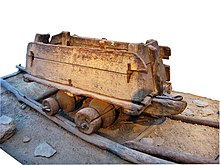
In 1515, Cardinal Matthäus Lang wrote a description of the Reisszug, a funicular railway at the Hohensalzburg Fortress in Austria. The line originally used wooden rails and a hemp haulage rope and was operated by human or animal power, through a treadwheel.[5] The line is still operational, although in updated form and is possibly the oldest operational railway.[6]
Wagonways (or tramways) using wooden rails, hauled by horses, started appearing in the 1550s to facilitate the transport of ore tubs to and from mines and soon became popular in Europe. Such an operation was illustrated in Germany in 1556 by Georgius Agricola in his work De re metallica.[7] This line used "Hund" carts with unflanged wheels running on wooden planks and a vertical pin on the truck fitting into the gap between the planks to keep it going the right way. The miners called the wagons Hunde ("dogs") from the noise they made on the tracks.[8]
There are many references to their use in central Europe in the 16th century.[9] Such a transport system was later used by German miners at Caldbeck, Cumbria, England, perhaps from the 1560s.[10] A wagonway was built at Prescot, near Liverpool, sometime around 1600, possibly as early as 1594. Owned by Philip Layton, the line carried coal from a pit near Prescot Hall to a terminus about one-half mile (800 m) away.[11] A funicular railway was also made at Broseley in Shropshire some time before 1604. This carried coal for James Clifford from his mines down to the River Severn to be loaded onto barges and carried to riverside towns.[12] The Wollaton Wagonway, completed in 1604 by Huntingdon Beaumont, has sometimes erroneously been cited as the earliest British railway. It ran from Strelley to Wollaton near Nottingham.[13]
The Middleton Railway in Leeds, which was built in 1758, later became the world's oldest operational railway (other than funiculars), albeit now in an upgraded form. In 1764, the first railway in the Americas was built in Lewiston, New York.[14]
Metal rails introduced


In the late 1760s, the Coalbrookdale Company began to fix plates of cast iron to the upper surface of the wooden rails. This allowed a variation of gauge to be used. At first only balloon loops could be used for turning, but later, movable points were taken into use that allowed for switching.[15]
A system was introduced in which unflanged wheels ran on L-shaped metal plates, which came to be known as plateways. John Curr, a Sheffield colliery manager, invented this flanged rail in 1787, though the exact date of this is disputed. The plate rail was taken up by Benjamin Outram for wagonways serving his canals, manufacturing them at his Butterley ironworks. In 1803, William Jessop opened the Surrey Iron Railway, a double track plateway, erroneously sometimes cited as world's first public railway, in south London.[16]
William Jessop had earlier used a form of all-iron edge rail and flanged wheels successfully for an extension to the Charnwood Forest Canal at Nanpantan, Loughborough, Leicestershire in 1789. In 1790, Jessop and his partner Outram began to manufacture edge rails. Jessop became a partner in the Butterley Company in 1790. The first public edgeway (thus also first public railway) built was Lake Lock Rail Road in 1796. Although the primary purpose of the line was to carry coal, it also carried passengers.
These two systems of constructing iron railways, the "L" plate-rail and the smooth edge-rail, continued to exist side by side until well into the early 19th century. The flanged wheel and edge-rail eventually proved its superiority and became the standard for railways.
Cast iron used in rails proved unsatisfactory because it was brittle and broke under heavy loads. The wrought iron invented by John Birkinshaw in 1820 replaced cast iron. Wrought iron, usually simply referred to as "iron", was a ductile material that could undergo considerable deformation before breaking, making it more suitable for iron rails. But iron was expensive to produce until Henry Cort patented the puddling process in 1784. In 1783 Cort also patented the rolling process, which was 15 times faster at consolidating and shaping iron than hammering.[17] These processes greatly lowered the cost of producing iron and rails. The next important development in iron production was hot blast developed by James Beaumont Neilson (patented 1828), which considerably reduced the amount of coke (fuel) or charcoal needed to produce pig iron.[18] Wrought iron was a soft material that contained slag or dross. The softness and dross tended to make iron rails distort and delaminate and they lasted less than 10 years. Sometimes they lasted as little as one year under high traffic. All these developments in the production of iron eventually led to the replacement of composite wood/iron rails with superior all-iron rails. The introduction of the Bessemer process, enabling steel to be made inexpensively, led to the era of great expansion of railways that began in the late 1860s. Steel rails lasted several times longer than iron.[19][20][21] Steel rails made heavier locomotives possible, allowing for longer trains and improving the productivity of railroads.[22] The Bessemer process introduced nitrogen into the steel, which caused the steel to become brittle with age. The open hearth furnace began to replace the Bessemer process near the end of the 19th century, improving the quality of steel and further reducing costs. Thus steel completely replaced the use of iron in rails, becoming standard for all railways.
The first passenger horsecar or tram, Swansea and Mumbles Railway was opened between Swansea and Mumbles in Wales in 1807.[23] Horses remained the preferable mode for tram transport even after the arrival of steam engines until the end of the 19th century, because they were cleaner compared to steam-driven trams which caused smoke in city streets.
Steam power introduced
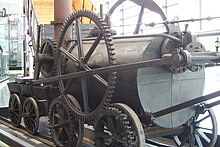
In 1784 James Watt, a Scottish inventor and mechanical engineer, patented a design for a steam locomotive. Watt had improved the steam engine of Thomas Newcomen, hitherto used to pump water out of mines, and developed a reciprocating engine in 1769 capable of powering a wheel. This was a large stationary engine, powering cotton mills and a variety of machinery; the state of boiler technology necessitated the use of low-pressure steam acting upon a vacuum in the cylinder, which required a separate condenser and an air pump. Nevertheless, as the construction of boilers improved, Watt investigated the use of high-pressure steam acting directly upon a piston, raising the possibility of a smaller engine that might be used to power a vehicle. Following his patent, Watt's employee William Murdoch produced a working model of a self-propelled steam carriage in that year.[24]
The first full-scale working railway steam locomotive was built in the United Kingdom in 1804 by Richard Trevithick, a British engineer born in Cornwall. This used high-pressure steam to drive the engine by one power stroke. The transmission system employed a large flywheel to even out the action of the piston rod. On 21 February 1804, the world's first steam-powered railway journey took place when Trevithick's unnamed steam locomotive hauled a train along the tramway of the Penydarren ironworks, near Merthyr Tydfil in South Wales.[25][26] Trevithick later demonstrated a locomotive operating upon a piece of circular rail track in Bloomsbury, London, the Catch Me Who Can, but never got beyond the experimental stage with railway locomotives, not least because his engines were too heavy for the cast-iron plateway track then in use.[27]
The first commercially successful steam locomotive was Matthew Murray's rack locomotive Salamanca built for the Middleton Railway in Leeds in 1812. This twin-cylinder locomotive was light enough to not break the edge-rails track and solved the problem of adhesion by a cog-wheel using teeth cast on the side of one of the rails. Thus it was also the first rack railway.
This was followed in 1813 by the locomotive Puffing Billy built by Christopher Blackett and William Hedley for the Wylam Colliery Railway, the first successful locomotive running by adhesion only. This was accomplished by the distribution of weight between a number of wheels. Puffing Billy is now on display in the Science Museum in London, and is the oldest locomotive in existence.[28][29]
In 1814, George Stephenson, inspired by the early locomotives of Trevithick, Murray and Hedley, persuaded the manager of the Killingworth colliery where he worked to allow him to build a steam-powered machine. Stephenson played a pivotal role in the development and widespread adoption of the steam locomotive. His designs considerably improved on the work of the earlier pioneers. He built the locomotive Blücher, also a successful flanged-wheel adhesion locomotive. In 1825 he built the locomotive Locomotion for the Stockton and Darlington Railway in the northeast of England, which became the first public steam railway in the world in 1825, although it used both horse power and steam power on different runs. In 1829, he built the locomotive Rocket, which entered in and won the Rainhill Trials. This success led to Stephenson establishing his company as the pre-eminent builder of steam locomotives for railways in Great Britain and Ireland, the United States, and much of Europe.[30]: 24–30 The first public railway which used only steam locomotives, all the time, was Liverpool and Manchester Railway, built in 1830.[31]
Steam power continued to be the dominant power system in railways around the world for more than a century.
Electric power introduced

The first known electric locomotive was built in 1837 by chemist Robert Davidson of Aberdeen in Scotland, and it was powered by galvanic cells (batteries). Thus it was also the earliest battery-electric locomotive. Davidson later built a larger locomotive named Galvani, exhibited at the Royal Scottish Society of Arts Exhibition in 1841. The seven-ton vehicle had two direct-drive reluctance motors, with fixed electromagnets acting on iron bars attached to a wooden cylinder on each axle, and simple commutators. It hauled a load of six tons at four miles per hour (6 kilometers per hour) for a distance of one and a half miles (2.4 kilometres). It was tested on the Edinburgh and Glasgow Railway in September of the following year, but the limited power from batteries prevented its general use. It was destroyed by railway workers, who saw it as a threat to their job security.[32][33][34]
Werner von Siemens demonstrated an electric railway in 1879 in Berlin. The world's first electric tram line, Gross-Lichterfelde Tramway, opened in Lichterfelde near Berlin, Germany, in 1881. It was built by Siemens. The tram ran on 180 volts DC, which was supplied by running rails. In 1891 the track was equipped with an overhead wire and the line was extended to Berlin-Lichterfelde West station. The Volk's Electric Railway opened in 1883 in Brighton, England. The railway is still operational, thus making it the oldest operational electric railway in the world. Also in 1883, Mödling and Hinterbrühl Tram opened near Vienna in Austria. It was the first tram line in the world in regular service powered from an overhead line. Five years later, in the U.S. electric trolleys were pioneered in 1888 on the Richmond Union Passenger Railway, using equipment designed by Frank J. Sprague.[35]
The first use of electrification on a main line was on a four-mile section of the Baltimore Belt Line of the Baltimore and Ohio Railroad (B&O) in 1895 connecting the main portion of the B&O to the new line to New York through a series of tunnels around the edges of Baltimore's downtown. Electricity quickly became the power supply of choice for subways, abetted by the Sprague's invention of multiple-unit train control in 1897. By the early 1900s most street railways were electrified.
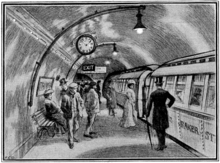
The London Underground, the world's oldest underground railway, opened in 1863, and it began operating electric services using a fourth rail system in 1890 on the City and South London Railway, now part of the London Underground Northern line. This was the first major railway to use electric traction. The world's first deep-level electric railway, it runs from the City of London, under the River Thames, to Stockwell in south London.[36]
The first practical AC electric locomotive was designed by Charles Brown, then working for Oerlikon, Zürich. In 1891, Brown had demonstrated long-distance power transmission, using three-phase AC, between a hydro-electric plant at Lauffen am Neckar and Frankfurt am Main West, a distance of 280 km (170 mi). Using experience he had gained while working for Jean Heilmann on steam–electric locomotive designs, Brown observed that three-phase motors had a higher power-to-weight ratio than DC motors and, because of the absence of a commutator, were simpler to manufacture and maintain.[b] However, they were much larger than the DC motors of the time and could not be mounted in underfloor bogies: they could only be carried within locomotive bodies.[38]
In 1894, Hungarian engineer Kálmán Kandó developed a new type 3-phase asynchronous electric drive motors and generators for electric locomotives. Kandó's early 1894 designs were first applied in a short three-phase AC tramway in Évian-les-Bains (France), which was constructed between 1896 and 1898.[39][40]
In 1896, Oerlikon installed the first commercial example of the system on the Lugano Tramway. Each 30-tonne locomotive had two 110 kW (150 hp) motors run by three-phase 750 V 40 Hz fed from double overhead lines. Three-phase motors run at a constant speed and provide regenerative braking, and are well suited to steeply graded routes, and the first main-line three-phase locomotives were supplied by Brown (by then in partnership with Walter Boveri) in 1899 on the 40 km Burgdorf–Thun line, Switzerland.
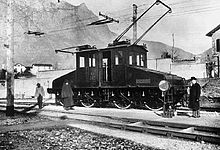
Italian railways were the first in the world to introduce electric traction for the entire length of a main line rather than a short section. The 106 km Valtellina line was opened on 4 September 1902, designed by Kandó and a team from the Ganz works.[41][42] The electrical system was three-phase at 3 kV 15 Hz. In 1918,[43] Kandó invented and developed the rotary phase converter, enabling electric locomotives to use three-phase motors whilst supplied via a single overhead wire, carrying the simple industrial frequency (50 Hz) single phase AC of the high-voltage national networks.[42]
An important contribution to the wider adoption of AC traction came from SNCF of France after World War II. The company conducted trials at AC 50 Hz, and established it as a standard. Following SNCF's successful trials, 50 Hz, now also called industrial frequency was adopted as standard for main-lines across the world.[44]
Diesel power introduced
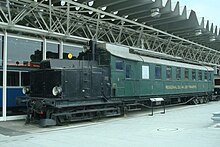
Earliest recorded examples of an internal combustion engine for railway use included a prototype designed by William Dent Priestman. Sir William Thomson examined it in 1888 and described it as a "Priestman oil engine mounted upon a truck which is worked on a temporary line of rails to show the adaptation of a petroleum engine for locomotive purposes."[45][46] In 1894, a 20 hp (15 kW) two axle machine built by Priestman Brothers was used on the Hull Docks.[47]
In 1906, Rudolf Diesel, Adolf Klose and the steam and diesel engine manufacturer Gebrüder Sulzer founded Diesel-Sulzer-Klose GmbH to manufacture diesel-powered locomotives. Sulzer had been manufacturing diesel engines since 1898. The Prussian State Railways ordered a diesel locomotive from the company in 1909. The world's first diesel-powered locomotive was operated in the summer of 1912 on the Winterthur–Romanshorn railway in Switzerland, but was not a commercial success.[48] The locomotive weight was 95 tonnes and the power was 883 kW with a maximum speed of 100 km/h (62 mph).[49] Small numbers of prototype diesel locomotives were produced in a number of countries through the mid-1920s. The Soviet Union operated three experimental units of different designs since late 1925, though only one of them (the E el-2) proved technically viable.[50]
A significant breakthrough occurred in 1914, when Hermann Lemp, a General Electric electrical engineer, developed and patented a reliable direct current electrical control system (subsequent improvements were also patented by Lemp).[51] Lemp's design used a single lever to control both engine and generator in a coordinated fashion, and was the prototype for all diesel–electric locomotive control systems. In 1914, world's first functional diesel–electric railcars were produced for the Königlich-Sächsische Staatseisenbahnen (Royal Saxon State Railways) by Waggonfabrik Rastatt with electric equipment from Brown, Boveri & Cie and diesel engines from Swiss Sulzer AG. They were classified as DET 1 and DET 2 (de.wiki). The first regular used diesel–electric locomotives were switcher (shunter) locomotives. General Electric produced several small switching locomotives in the 1930s (the famous "44-tonner" switcher was introduced in 1940) Westinghouse Electric and Baldwin collaborated to build switching locomotives starting in 1929.
In 1929, the Canadian National Railways became the first North American railway to use diesels in mainline service with two units, 9000 and 9001, from Westinghouse.[52]
High-speed rail
Although steam and diesel services reaching speeds up to 200 km/h (120 mph) were started before the 1960s in Europe, they were not very successful.[citation needed]

The first electrified high-speed rail Tōkaidō Shinkansen was introduced in 1964 between Tokyo and Osaka in Japan. Since then high-speed rail transport, functioning at speeds up to and above 300 km/h (190 mph), has been built in Japan, Spain, France, Germany, Italy, the People's Republic of China, Taiwan (Republic of China), the United Kingdom, South Korea, Scandinavia, Belgium and the Netherlands. The construction of many of these lines has resulted in the dramatic decline of short-haul flights and automotive traffic between connected cities, such as the London–Paris–Brussels corridor, Madrid–Barcelona, Milan–Rome–Naples, as well as many other major lines.[citation needed]
High-speed trains normally operate on standard gauge tracks of continuously welded rail on grade-separated right-of-way that incorporates a large turning radius in its design. While high-speed rail is most often designed for passenger travel, some high-speed systems also offer freight service.
Preservation
Since 1980, rail transport has changed dramatically, but a number of heritage railways continue to operate as part of living history to preserve and maintain old railway lines for services of tourist trains.
Trains
A train is a connected series of rail vehicles that move along the track. Propulsion for the train is provided by a separate locomotive or from individual motors in self-propelled multiple units. Most trains carry a revenue load, although non-revenue cars exist for the railway's own use, such as for maintenance-of-way purposes. The engine driver (engineer in North America) controls the locomotive or other power cars, although people movers and some rapid transits are under automatic control.
Haulage
Traditionally, trains are pulled using a locomotive. This involves one or more powered vehicles being located at the front of the train, providing sufficient tractive force to haul the weight of the full train. This arrangement remains dominant for freight trains and is often used for passenger trains. A push–pull train has the end passenger car equipped with a driver's cab so that the engine driver can remotely control the locomotive. This allows one of the locomotive-hauled train's drawbacks to be removed, since the locomotive need not be moved to the front of the train each time the train changes direction. A railroad car is a vehicle used for the haulage of either passengers or freight.
A multiple unit has powered wheels throughout the whole train. These are used for rapid transit and tram systems, as well as many both short- and long-haul passenger trains. A railcar is a single, self-powered car, and may be electrically propelled or powered by a diesel engine. Multiple units have a driver's cab at each end of the unit, and were developed following the ability to build electric motors and other engines small enough to fit under the coach. There are only a few freight multiple units, most of which are high-speed post trains.
Motive power
Steam locomotives are locomotives with a steam engine that provides adhesion. Coal, petroleum, or wood is burned in a firebox, boiling water in the boiler to create pressurized steam. The steam travels through the smokebox before leaving via the chimney or smoke stack. In the process, it powers a piston that transmits power directly through a connecting rod (US: main rod) and a crankpin (US: wristpin) on the driving wheel (US main driver) or to a crank on a driving axle. Steam locomotives have been phased out in most parts of the world for economical and safety reasons, although many are preserved in working order by heritage railways.
Electric locomotives draw power from a stationary source via an overhead wire or third rail. Some also or instead use a battery. In locomotives that are powered by high-voltage alternating current, a transformer in the locomotive converts the high-voltage low-current power to low-voltage high current used in the traction motors that power the wheels. Modern locomotives may use three-phase AC induction motors or direct current motors. Under certain conditions, electric locomotives are the most powerful traction.[citation needed] They are also the cheapest to run and provide less noise and no local air pollution.[citation needed] However, they require high capital investments both for the overhead lines and the supporting infrastructure, as well as the generating station that is needed to produce electricity. Accordingly, electric traction is used on urban systems, lines with high traffic and for high-speed rail.
Diesel locomotives use a diesel engine as the prime mover. The energy transmission may be either diesel–electric, diesel-mechanical or diesel–hydraulic but diesel–electric is dominant. Electro-diesel locomotives are built to run as diesel–electric on unelectrified sections and as electric locomotives on electrified sections.
Alternative methods of motive power include magnetic levitation, horse-drawn, cable, gravity, pneumatics and gas turbine.
Zdroj:https://en.wikipedia.org?pojem=Rail_transport
Text je dostupný za podmienok Creative Commons Attribution/Share-Alike License 3.0 Unported; prípadne za ďalších podmienok. Podrobnejšie informácie nájdete na stránke Podmienky použitia.
Antropológia
Aplikované vedy
Bibliometria
Dejiny vedy
Encyklopédie
Filozofia vedy
Forenzné vedy
Humanitné vedy
Knižničná veda
Kryogenika
Kryptológia
Kulturológia
Literárna veda
Medzidisciplinárne oblasti
Metódy kvantitatívnej analýzy
Metavedy
Metodika
Text je dostupný za podmienok Creative
Commons Attribution/Share-Alike License 3.0 Unported; prípadne za ďalších
podmienok.
Podrobnejšie informácie nájdete na stránke Podmienky
použitia.
www.astronomia.sk | www.biologia.sk | www.botanika.sk | www.dejiny.sk | www.economy.sk | www.elektrotechnika.sk | www.estetika.sk | www.farmakologia.sk | www.filozofia.sk | Fyzika | www.futurologia.sk | www.genetika.sk | www.chemia.sk | www.lingvistika.sk | www.politologia.sk | www.psychologia.sk | www.sexuologia.sk | www.sociologia.sk | www.veda.sk I www.zoologia.sk
